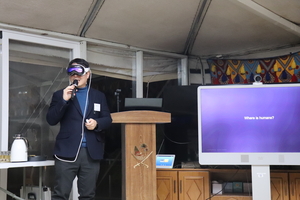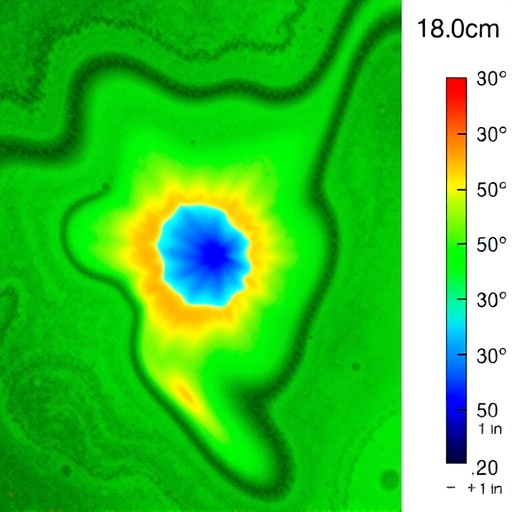In the continuously evolving landscape of biomedical engineering and artificial intelligence, researchers have taken a monumental leap forward by developing an advanced method to non-invasively predict core body temperature in extreme environments. This groundbreaking work, presented by Strickland, Ghisoni, Marshall, and colleagues in the upcoming 2025 issue of Communications Engineering, introduces a novel conformal deep learning approach that promises to revolutionize thermal monitoring in humans. This technology seamlessly integrates cutting-edge machine learning with physiological understanding, paving the way for improved health and safety monitoring in arenas where traditional measurement techniques fail or become impractical.
Technical Approach
Core body temperature is a critical physiological parameter that reflects thermal balance within the human body. Maintaining this temperature within a narrow range is vital for optimal metabolic and enzymatic functions. In extreme environments — whether blistering deserts, frigid polar regions, or high-altitude mountaintops — the body’s thermal equilibrium is constantly under threat. Conventional methods for measuring internal temperature, such as ingestible thermistors or invasive probes, are unsuitable for many field applications due to discomfort, cost, time delay, and risk of contamination. Consequently, this research targets an acute and unmet need: developing a non-invasive, real-time, and reliable prediction mechanism for core temperatures under such harsh conditions.
At the heart of this innovation lies the concept of conformal deep learning, a sophisticated branch of artificial intelligence that not only focuses on prediction accuracy but also quantifies the uncertainty of these predictions. Traditional deep learning models offer point estimates without robust confidence metrics, which can be problematic in critical medical applications where erroneous decisions can have severe consequences. Conformal prediction frameworks address this by producing prediction intervals that contain the true value with a user-specified probability, thereby enabling safer and more trustworthy implementation.
The research team employed physiological signals measurable from the skin surface, including thermal imaging data, ambient environmental parameters, and cardiovascular indicators like heart rate variability. These multimodal inputs provide a rich informational substrate that reflects the dynamic heat exchange occurring between the body and its surroundings. Through preprocessing stages, the team normalized inputs to account for sensor variability and noise, ensuring stability and robustness of the deep learning model. This preprocessing is crucial in extreme environments where sensor reliability can be compromised by moisture, dust, or mechanical disturbances.
Results and Findings
To build their model, the researchers utilized a convolutional neural network (CNN) architecture tailored for the temporal-spatial nature of the physiological signals. CNNs have shown exceptional success in extracting meaningful features from image and time-series data. However, integrating conformal prediction into the CNN required the design of specialized calibration algorithms that adaptively adjust prediction intervals based on real-time data distributions encountered in test conditions. This adaptive calibration is a critical advancement that handles concept drift—changes in data distribution common in non-stationary environments.
Field validation of the model involved controlled simulations in environmental chambers replicating extreme heat and cold. Volunteers subjected to these conditions wore non-invasive monitoring devices while their internal temperatures were concurrently measured by ingestible sensors to provide ground-truth data. The conformal deep learning model demonstrated remarkable predictive capabilities with high accuracy and well-calibrated confidence intervals, substantially outperforming existing non-invasive temperature estimation methods.
An impressive hallmark of this research is the model’s ability to quantify uncertainty in scenarios where physiological signals become ambiguous due to rapid environmental shifts or participant movement. This probabilistic insight allows healthcare providers or field operators to gauge the reliability of temperature estimates and decide when invasive verification might be necessary. In high-stakes environments, such as military operations or mountaineering expeditions, this feature could mean the difference between timely intervention and catastrophic failure.
Research Significance and Applications
Beyond its immediate applications in extreme environments, the methodology devised by Strickland and colleagues has broad implications for telemedicine and wearable health technology. As wearable devices become ubiquitous, embedding conformal deep learning models could upgrade them from simple trackers to sophisticated diagnostic tools with embedded risk assessments. This could be transformative for managing chronic conditions like fever monitoring in infectious disease outbreaks or optimizing heat stroke prevention in athletes and outdoor workers.
Further research plans articulated by the team focus on integrating additional physiological markers such as sweat composition, respiration rates, and skin conductance, which could further refine the predictive power of the model. The fusion of biochemical data with thermal and cardiovascular signals represents a promising frontier to capture the multifaceted nature of human thermoregulation. They also emphasize the importance of expanding demographic diversity in training datasets to ensure robustness across different ages, ethnicities, and fitness levels.
The computational efficiency of the model is notable. By leveraging edge computing paradigms, the system can operate on lightweight processors embedded in wearable devices, delivering near real-time predictions without relying on cloud connectivity. This feature is essential for deployment in remote areas or disaster zones where network access is limited or unreliable, guaranteeing uninterrupted health monitoring.
The impact of this technology transcends individual health management. In industrial workplaces requiring heat stress monitoring, such conformal AI tools could automate safety protocols, reduce labor costs, and mitigate risks of heat-related injuries. Likewise, in space exploration missions, where human survival hinges on precise monitoring of physiological parameters in alien climates, such technology could become indispensable.
However, the implementation of conformal deep learning in core temperature prediction also carries challenges. The interpretability of deep learning models remains imperfect; while uncertainty quantification improves trust, understanding exactly how features map onto predictions is an ongoing research area. The team acknowledges the necessity of developing transparent AI models that can be audited and verified by clinicians and regulators to foster widespread adoption.
In summary, this pioneering investigation into conformal deep learning for non-invasive core body temperature prediction presents not only a technological breakthrough but also a paradigm shift in physiological monitoring under extreme conditions. The integration of uncertainty awareness into deep AI applications heralds a new era of trustworthy, context-aware health assessments. The forthcoming publication by Strickland et al. promises to inspire a wave of innovations that could safeguard millions in hostile environments and beyond.
Subject of Research: Non-invasive core body temperature prediction using conformal deep learning in extreme environments.
Article Title: Degrees of uncertainty: conformal deep learning for non-invasive core body temperature prediction in extreme environments.
Article References:
Strickland, J., Ghisoni, M., Marshall, H. et al. Degrees of uncertainty: conformal deep learning for non-invasive core body temperature prediction in extreme environments. Commun Eng (2025). https://doi.org/10.1038/s44172-025-00548-6
Image Credits: AI Generated
 Google DeepMind Launches AI Lab in Singapore to Enhance Regional Language Understanding
Google DeepMind Launches AI Lab in Singapore to Enhance Regional Language Understanding Google Reveals Nested Learning to Combat Catastrophic Forgetting in LLMs
Google Reveals Nested Learning to Combat Catastrophic Forgetting in LLMs Alphabet Shares Surge 9.4% After Buffett Invests $4.3B, Launching Gemini 3 AI
Alphabet Shares Surge 9.4% After Buffett Invests $4.3B, Launching Gemini 3 AI Cofounder Cited in False Reference; Psychiatry Research Faces Undisclosed COIs
Cofounder Cited in False Reference; Psychiatry Research Faces Undisclosed COIs AI Study Reveals Generated Faces Indistinguishable from Real Photos, Erodes Trust in Visual Media
AI Study Reveals Generated Faces Indistinguishable from Real Photos, Erodes Trust in Visual Media






























































